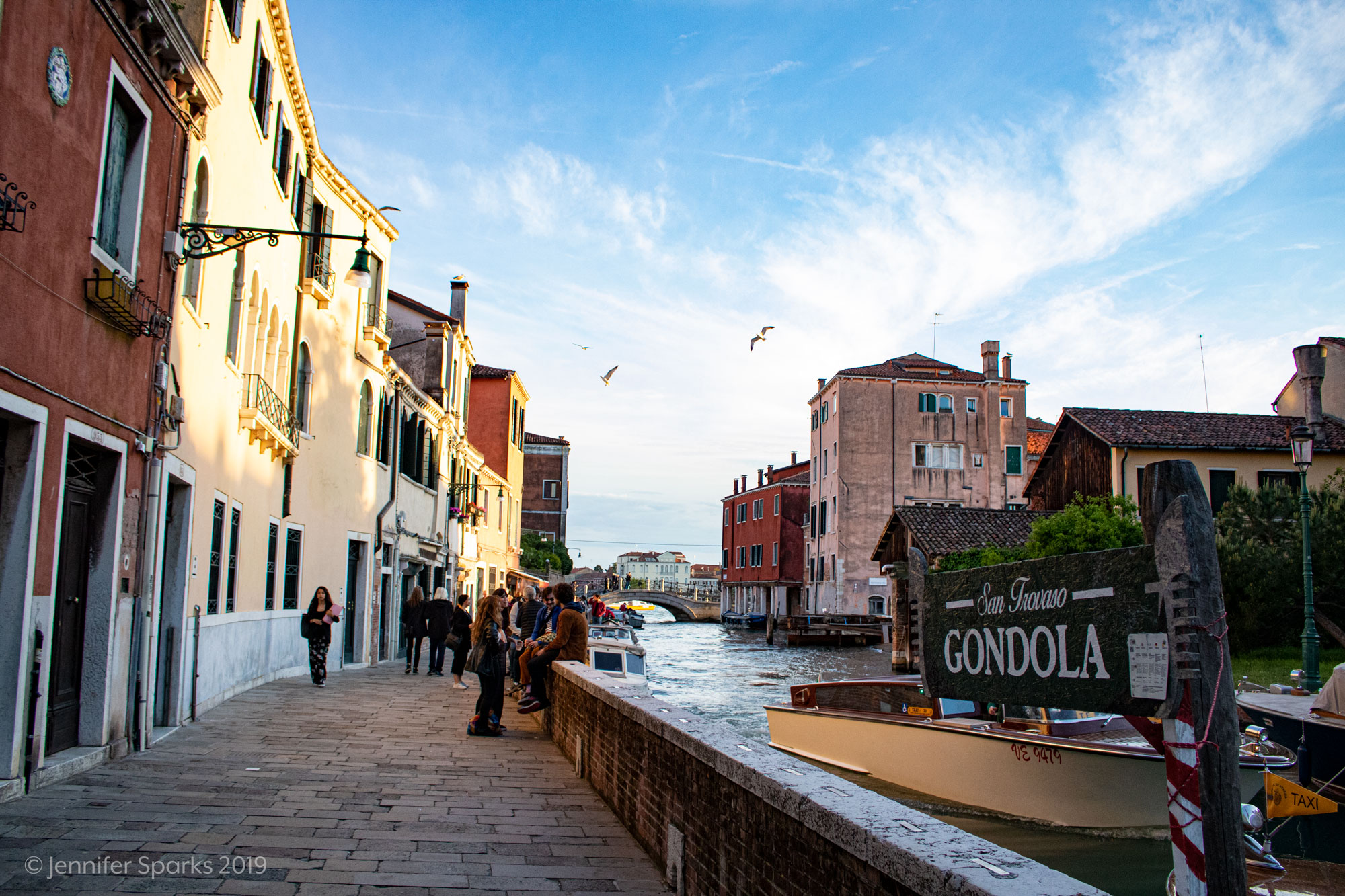Venice
Venice
City in the sea
Some places aren’t all they’re cracked up to be. Venice is not one of them. Venice is magic.
The train making its way across the bridge to Santa Lucrezia station offers the first glimpses of red roofs and church spires out to sea.
Venice is a paradise for an amateur or professional photographer, or a casual tourist who wants nothing more than to sink into the ambience of the city. The canals. The bridges. The gondolas with their dapper gondoliers. Turning corners can lead dramatic views and moments of a muttered “wow, wow, wow”.











Popping out from the alley ways onto the Grand Canal is one of them. Following the music and finding a block party celebrating a local artist’s birthday is another.
I had five days to enjoy, and I just happened to catch the city right after the beginning of the Biennale art festival. I also happened to be there for five days of rain, which made me far more willing than usual to spend time in museums. Incidentally, there is a marvelous deal where you can buy a pass to 10 museums (including the not-to-be-missed Doge’s Palace) for 25 Euros. Given that an entry into the Doge’s Palace alone is 19 Euros, it pays for itself quickly.
Sunset over the gondola boat-works.
The Doge’s Palace is impressive both for its scale and for the amount of history that has happened inside its doors. Home to Europe’s largest room, the vastness and richness of the building are not subtle. It was designed to project power and prestige, in a hit-you-over-the-head sort of way. And it succeeds.
I accidentally took myself on the extended dungeon tour, which was perhaps not the part of the building that I would have liked to have concentrated on. It is, as one might expect, rather less well appointed than the main area—quite dank and dreary if I do say so.
But one of Venice’s most notable landmarks, the Bridge of Sighs, has a direct connection to the dungeons of the Doge’s Palace. It is where prisoners, condemned to die, got their last glimpse of the city on their way to being executed.



It feels like there are acres of polished wood floors and elaborately painted ceilings. Armies of long-dead Doges stare down from the walls, and despite a lifetime of believing whole-heartedly in the equality of humans before God and fellow man, it is hard to not feel a little intimidated by the sheer weight of history and the amount of power that was once wielded in those halls.
The Palace and Basilica share a complex, centering political and religious powers into one nucleus of dominance. Entering into the floor-to-ceiling mosaic spectacular of St. Mark’s Basilica definitely falls in the “wow” category (just make sure to leave your backpacks at the hotel, as they’re not allowed into the Basilica). It is worth going when there are no cruise ships harbored because the crowds are significantly more manageable, and you can take the time to just let your eyes feast without being jostled along with the crowd.
The statues of St. Mark’s Basilica and the Doge’s Palace are engaged in a never ending staring contest.
Beyond the labyrinthine joys of the main city, are other islands in the archipelago. Torcello is the place where Venice got its start when people fled the oncoming horde of Atila the Hun’s army.
The colorful island of Burano is a hotbed of lace making, and very delightfully colored houses lining the canals. Tickets to the lace museum on Burano (closed Mondays!) and the glass museum on Morano are included in the museum ticket deal.


Connected to Burano by a footbridge is the small island of Mazzorbo. Very tranquil and charming, it is home to the Venissa vinyard which contains a walled area that acts as vinyard/sculpture garden combined. It’s free to walk through, allowing visitors the pleasure of the glorious roses planted as a warning about diseases (they show signs of disease before the vines do) at the beginning of each row of grapes.
Walled vineyards on Mazzorbo.
And famous Murano and its glassmaking patrimonial heritage is a charming extension of the city, easily reached in a day by the regularly running vaporetto boats which serve as public transportation. Its definitely worth buying a day pass to visit Torcello, Burano and Murano as a day trip.
Towers of Murano.
All things considered, Venice is a joy and a pleasure. it is easy to see how the crowds from cruise ships can take such a toll on the city. Lines swell, the downtown is absolutely slammed, and it’s hard to navigate through the crowds. But it doesn’t take long to get away from the hubbub and into the more quiet neighborhoods.
I happened to find a beautiful little untouched pocket of the city. The rain had let up for a few moments, and I had just stepped out of one of the Biennale exhibits and decided to get lost. Turning up a side street I came into a little neighborhood courtyard overflowing with riotously colored potted flowers. A man was standing in his doorway attempting to coax an outrageously fluffy and deeply unimpressed cat into the house. Both person and cat gave me the eyeball, and I felt a bit like an interloper so retraced my steps without delay.
But it was a small, charming vignette the summed up the tone of Venice. Amongst the grandeur, the history, the pomp, the impressiveness of Venice, its humanity has built and sustained it.
Sunset over the canals.



